
News
Study on Micro texture of "SE+PERC" Monocrystalline Silicon Solar Cell Texturing Process
Release time: 2022-10-26
Source: Chen Susu, Yan Huizhen, Liu Miao, etc. Study on the micro texture of "SE+PERC" monocrystalline silicon solar cell in the texturing process [J]Solar energy, 2022 (3): 82-86
In order to achieve the goal of carbon peaking and carbon neutralization, photovoltaic power generation, as an important renewable and clean energy utilization mode, will be more and more widely used in China. As the core component of photovoltaic power generation, solar cells have developed rapidly in recent years. Among them, monocrystalline silicon solar cells have always occupied the vast majority of the market shares by virtue of their advantages such as high photoelectric conversion efficiency and good performance [1].
The degree of texture on the surface of monocrystalline silicon can directly affect its reflectivity to sunlight, thus affecting the photoelectric conversion efficiency of monocrystalline silicon solar cells. The texturing of silicon wafer surface is to use low concentration NaOH solution to etch the front and back of silicon wafer, thus forming a pyramid structure on the front and back of silicon wafer. This structure can not only increase the light absorption rate of the front side of the solar cell, but also reflect the sunlight reflected once again back into the solar cell to achieve secondary absorption [2], thereby increasing the photogenerated current of the solar cell and improving the photoelectric conversion efficiency of the solar cell. The texturing on the back of silicon wafer can prepare for the subsequent backscattering process. In recent years, with the popularity of texturization additives, the micro textured surface of silicon wafer and the time of texturing process have been greatly improved, and the pyramid size on the micro textured surface has changed from 7μm down to 3μm or so. For the texturing of silicon wafer surface, a small and uniform pyramid structure can have more light absorption area than a large pyramid structure, which can improve the light absorption of solar cells.
In order to improve the photoelectric conversion efficiency of monocrystalline silicon solar cells, this paper takes the monocrystalline silicon solar cells (i.e. "SE+PERC" monocrystalline silicon solar cells) with selective emitter (SE), passive emitter and back contact (PERC) technologies as an example, and optimizes the process content in the texturing process of the solar cells without increasing any cost, The small and uniform pyramid structure was obtained, and the performance of "SE+PERC" monocrystalline silicon solar cells prepared by different pyramid sizes was tested.
Experimental Design
Experimental Instrument
The microstructure of silicon wafers after texturing is scanned by ProX energy spectrometer produced by Funa Scientific Instruments (Shanghai) Co., Ltd; The reflectivity of silicon wafers after texturing is tested by the REF300 reflectometer produced by Department Optoelectronics Technology (Shanghai) Co., Ltd; The weight loss data before and after silicon chip texturing are measured by high-precision electronic balance; The photoelectric conversion efficiency of the finished solar cell is measured by the high-precision I-V measurement system produced by the German HALM company.
Experimental sample processing and experimental process design
The experimental silicon chip is cut from the same silicon rod produced by JA Solar Co., Ltd. with a size of 158mm×158mm single crystal silicon wafer, the resistivity range of silicon wafer is 0.4 ~ 1.1 Ω• cm, and the thickness of silicon wafer is 165 ~ 175μm。
The texturing process flow of monocrystalline silicon wafer is shown in Figure 1. In this experiment, by changing the content of a certain process in the texturing process, 9 different kinds of silicon wafer samples were obtained; Then the corresponding test shall be carried out for the process changed by a sample; Finally, under the same preparation conditions, these nine silicon wafer samples were made into "SE+PERC" solar cells according to the preparation process of "SE+PERC" solar cells, and the performance of the prepared solar cells was tested.

All the samples of monocrystalline silicon chips only change the content of one process in the velvet making process, while the other processes remain unchanged. The process contents of 9 samples are as follows:
1) Sample 1: Low weight loss during rough polishing;
2) Sample 2: high weight loss during rough polishing;
3) Sample 3: low concentration of texturization additive is used;
4) Sample 4: High concentration texturization additive is used;
5) Sample 5: High concentration NaOH solution is used;
6) Sample 6: use low concentration NaOH solution;
7) Sample 7: adopt different texturing time;
8) Sample 8: The amount of solution discharged from the texturing tank (hereinafter referred to as "regular discharge") is less than the amount of solution added (hereinafter referred to as "supplement");
9) Regular discharge equals supplement. The weight loss data of these 9 kinds of silicon wafers before and after flanging were measured, micro texturing surface scanning and reflectivity test were carried out with corresponding instruments, and the data were collected for analysis.
Experimental results and analysis
Since the concentration and temperature of NaOH solution used for sample 1 and sample 2 are the same, the polishing time needs to be increased to achieve high weight loss during rough polishing of sample 2. Set the polishing time of sample 1 to 30s and sample 2 to 180s. The weight loss test results of both are shown in Figure 2. It can be seen from Figure 2 that the weight loss of sample 1 is 0.05g and that of sample 2 is 0.30g.
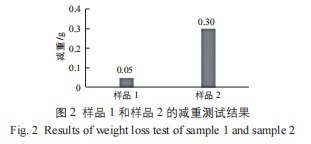
In order to analyze the impact of weight loss on pyramid size during rough polishing, the pyramid size of sample 1 and sample 2 was tested, and the test results are shown in Figure 3. Among them, the number of slots in the figure refers to the number of uses of the texturing slot. The corrosive liquid in the texturing slot can be used for 400 times in total. In this paper, the first four times of the texturing slot (1 slot to 4 slots) and the following 100 slots to 400 slots are selected for analysis, so as to facilitate the study of the impact of corrosive liquid in the texturing slot on the pyramid size at different times.
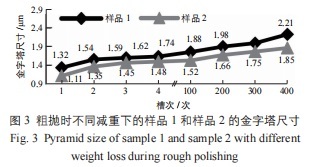
Although the weight loss of sample 1 is less than that of sample 2, it can be seen from Figure 3 that the pyramid size of sample 1 is larger than the pyramid size of sample 2, which indicates that the smaller the weight loss during rough polishing, the larger the pyramid size, and the size of weight loss during rough polishing is inversely related to the size of pyramid size. This is because the damage layer formed by cutting on the surface of low weight loss silicon wafer is easy to be removed, which leads to the existence of "steps" on the surface. The location with poor surface roughness of silicon wafer is prone to adhesion and nucleation during the texturing process, and the pyramid size formed will be larger. According to literature [3], the chemical reaction in the texturing process generally starts from the defects and impurities on the surface of crystalline silicon, and there are few defects and impurities on the surface of monocrystalline silicon chip that has removed the damaged layer. Therefore, with the reaction process going on, the surface of the silicon wafer with small weight loss is easy to form a large pile with larger pyramid size, while the surface of the silicon wafer with large weight loss will form a small pile with smaller pyramid size.
In the texturing process, the lower the concentration of the texturing additive, the higher the concentration of NaOH solution. Therefore, samples 3 to 6 can be considered as changing only the concentration of texturing additive in the texturing process, while other processes remain unchanged. The pyramid size under different concentration of texturing additive and NaOH solution is shown in Fig. 4 and Fig. 5.
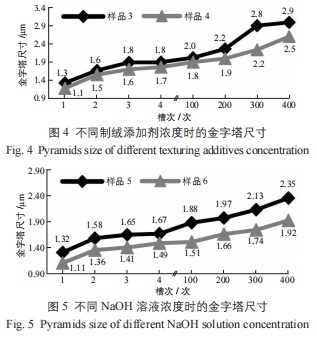
It can be seen from Figure 4 and Figure 5 that the pyramid size of sample 3 and sample 5 is large, because the lower the concentration of the texturing additive, the smaller the obstacle of hydroxyl (- OH) to reach the silicon wafer surface, the more it can promote the corrosion, which leads to the rapid growth of the pyramid after nucleation on the silicon wafer surface, forming a large pile surface with larger pyramid size. The pyramid size of sample 4 and sample 6 is relatively small, which is because the high concentration of texturing additive will hinder the transmission of - OH to the corrosion interface. After the pyramid nucleates on the silicon wafer surface, the corrosion rate of - OH is slow, and it is easy to form a small pile with smaller pyramid size. However, the effect is limited by increasing the concentration of texturing additive to achieve a small pile surface with smaller pyramid size. When the concentration of texturing additive is high to a certain extent, the anisotropy of monocrystalline silicon chips is weakened, and the rough polishing effect is enhanced. After the texturing process is completed, a pile surface without pyramid structure will be formed [4].
The micro morphology and reflectivity of sample 7 at different texturing times were tested, and the pyramid size and reflectivity at different texturing times were obtained, as shown in Figure 6 and Figure 7 respectively.
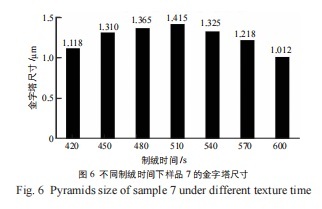
It can be seen from Figure 6 that, with the increase of milling time, the pyramid size increases within 510s; But after more than 510s, the pyramid size began to decrease gradually; The variation of pyramid size with milling time is approximately normal distribution. This is because the excessive corrosion will occur if the texturing time is too long, resulting in the reduction of the pyramid size.
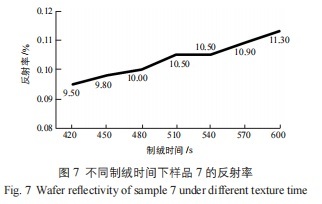
It can be seen from Figure 7 that the reflectivity of sample 7 increases with the increase of the texturing time.
In order to improve the reactivity of the corrosive solution by improving the metabolic amount of the corrosive solution during texturing, the regular discharge and supplement were adjusted. When the fixed row is less than the supplement (i.e. sample 8) and the fixed row is equal to the supplement (i.e. sample 9), the pyramid size of the sample after texturing can be obtained respectively, as shown in Figure 8.
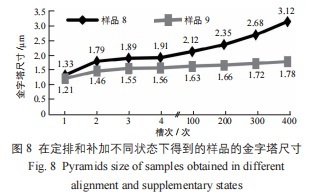
It can be seen from Figure 8 that the pyramid size of sample 8 is larger than that of sample 9. This is because when the regular discharge is less than the supplement, the corrosion product sodium silicate of the solution in the texturing tank accumulates more and the viscosity of the solution increases. If the excess waste liquid is discharged only by the overflow in the texturing tank, the circulating fluidity of the solution will become worse. Therefore, the corrosion uniformity of the silicon wafer surface is poor, and the pyramid size of the silicon wafer surface will become larger and larger with the accumulation of the use times of the texturing tank. In addition, when the content of sodium silicate in the corrosion solution is too high, the viscosity of the solution increases, and the reaction between Si and - OH is restrained. The corrosion of NaOH solution is difficult to form an ideal antireflection surface on the surface of monocrystalline silicon [5].
Under the condition that the constant discharge is equal to the supplement, the amount of solution in the texturing tank is small. Although the liquid level of the solution is low, it can meet the needs of immersion without overflow, and the circulation of the solution is fast, with more updates, so that the cumulative amount of reaction products in the solution is greatly reduced, and the corrosion rate of the surface of monocrystalline silicon wafer is the most uniform; At the same time, it speeds up the separation of reaction products on the surface of monocrystalline silicon wafer, reduces the self supplement amount of NaOH solution, and increases the activity of solution, which makes more nucleation points on the surface of monocrystalline silicon wafer, forming a small pile surface with smaller pyramid size, and the stability of pile surface is better with the increase of the number of use of the texturing tank. Therefore, the textured surface of sample 9 is the most stable, which is also the best state pursued in actual production.
Based on the above experimental results, it can be found that on the basis of regular arrangement equal to supplement, increasing the weight loss during rough polishing, reducing the concentration of NaOH solution or increasing the concentration of texturing additive can form a small and uniform pile surface with pyramid structure on the silicon wafer surface, as shown in Figure 9.
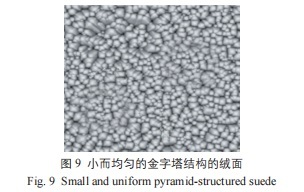
On the basis that the fixed row is equal to the supplement, by adjusting the weight loss during rough polishing, the texturing time, the concentration of NaOH solution and the concentration of the texturing additive, the samples of monocrystalline silicon chips with different pyramid sizes are prepared, and then all the samples of monocrystalline silicon chips are prepared into "SE+PERC" monocrystalline silicon solar cells, Then the electrical performance data of "SE+PERC" monocrystalline silicon solar cells with different pyramid sizes are obtained through testing, as shown in Table 1.

It can be seen from Table 1 that, on the basis of constant row equal to supplement, with the increase of pyramid size, the Isc of "SE+PERC" monocrystalline silicon solar cells shows a downward trend, and Rs and IRev2 both show an upward trend. This is because the doping at the top of the pyramid is heavier and the doping at the bottom is weaker during diffusion, which is more likely to occur in large textured surfaces with larger pyramid sizes, However, it rarely appears in the small textured surface with smaller pyramid size. Therefore, smaller pyramid size is more conducive to reducing the contact resistance of metal electrode and IRev2 [2] of solar cell, thus improving its Eta.
Conclusion
In this paper, by adjusting the process content in the texturing process, the pyramid size of the adjusted monocrystalline silicon chip texturing surface is tested, and the electrical performance of the "SE+PERC" monocrystalline silicon solar cells prepared based on different pyramid sizes is tested, and the following conclusions are obtained:
1) During rough polishing, high weight loss is more conducive to the formation of small pile with smaller pyramid size, and more conducive to the removal of damage layer formed by cutting on the silicon wafer surface;
2) Increasing the concentration of texturization additive or decreasing the concentration of NaOH solution will help to slow down the corrosion reaction and form a small textured surface with smaller pyramid size;
3) The relationship between texturing time and pyramid size is approximately normal distribution;
4) When the amount of solution discharged from the texturing tank is equal to the amount of solution added, the metabolism of the solution is faster, the corrosion reaction is more uniform, and the pyramid size of the textured surface is smaller and the structure is more stable;
5) The photoelectric conversion efficiency of "SE+PERC" monocrystalline silicon solar cells prepared from silicon chips with small pyramid size is higher when the amount of solution discharged from the textured tank is equal to the amount of solution added.
Author | Chen Susu, Yan Huizhen, Liu Miao, Zhang Junjie, Li Wentao
Unit | Source of JA Solar Energy Co., Ltd. | 3rd Issue of Solar Energy Magazine in 2022 P82-P86
DOI:10.19911/j.1003-0417.tyn20201222.01
Original link: https://mp.weixin.qq.com/s/b3W910SLbd72f1iJHAOs3A


